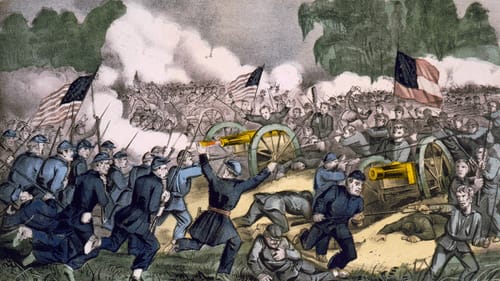Stay in the Loop
BSR publishes on a weekly schedule, with an email newsletter every Wednesday and Thursday morning. There’s no paywall, and subscribing is always free.
A historic finish
Should we honor “hallowed” ground at Gettysburg by running marathons there?

It was dark, below freezing in the small parking lot in Gettysburg, Pennsylvania. Dashboards glowed out 6:23am in the predawn gloom, and exhaust filtered like smoke into the crisp autumn air. By 6:55am, most of the athletes had left the refuge of their cars and gravitated to a subdued start line. At 7am, when the start gun fired, the sun was just barely beginning to glint off frosty grass.
The 2018 Gettysburg Battlefield Half-Marathon got off to an inauspicious start. Its premature ending some 11 miles and two hours later, after the lead biker took a wrong turn and race organizers were unable to redirect the runners, wasn’t much better.
“Very sorry”
As it turned out, the mishap was just one of many for the annual event. Its full-marathon counterpart, the Gettysburg Battlefield Marathon, had been canceled without warning just a month prior, and registration had been low for both. The day after the half-marathon, on November 4, 2018, all participants, including myself, received an apologetic email from race director Alex Hayes about seeking permissions from the National Park Service (NPS).
“We are very sorry… Last year, we applied for our permit in November and did not receive a denial until March. We appealed that decision and won, in June. The late start hurt us in many ways and led to us cancelling the full [marathon].”
“Most of you know the NPS higher-ups are not wild about us running on hallowed ground. We strongly feel that it is another way for people to appreciate what happened here 155 years ago,” the email continued, noting that the National Park Service had indicated plans to deny the permit in 2019. Hayes wrote that race organizers were working on a “Plan B” that wouldn’t require NPS approval (noting the new course would be “beautiful” but “not quite as meaningful”) and were hoping to change minds among NPS leadership while working with a new, more flexible and supportive partner.
Running commentary
And that appeared to be the end of it. Over the following year, neither I nor my fellow runners received further updates from Hayes on the 2019 race-permitting process, Gettysburg National Military Park issued no comment, and local media made no mention of any ongoing dispute about the marathon.
In January 2019, however, an article in the Gettysburg Times noted that the longstanding YWCA-sponsored “Spirit of Gettysburg” 5K race is also being threatened with permit denial in 2019. As reported by the Times, YWCA races at Gettysburg constituted 15 percent of the charity’s fundraising and events budget last year, and the YWCA also shares the proceeds of the half and full marathons with the Gettysburg Foundation (an organization supporting the national park). Race organizers were reportedly “dumbfounded.”
As the 2019 race season warms up in central PA (see recent articles on the Broad Street Run by editors Kyle Hiller and Alaina Johns), last year’s debacle at the Gettysburg Battlefield Half Marathon and the silent, continuing struggle of race organizers in general cast light on restrictions on how, and for whom, American history can be physically interpreted at national military and historical parks.

A Revolutionary run
Pennsylvania, and the Greater Philadelphia region in particular, are home to an impressive number of national historical sites. Many of these have successfully held their own races for years, often with the support of tourism bureaus and the parks themselves. In a personal email, Kirsten Tallman, race director of the five-mile Valley Forge Revolutionary Run, wrote, “Valley Forge was a training ground for Washington and his Continental Army…The determination that Washington and the troops experienced at Valley Forge echoes hundreds of years later with the runners that set out on their personal journey.” Administrators at Valley Forge National Historical Park seem to concur; the race has been held there annually for 13 years.
Clearly, Tallman’s response has the brassy ring of self-promotion. Running five miles in a pair of Nike Air Zooms is hardly typhoid-ridden encampment and subzero drilling under von Steuben.
Learning the landscape
Yet the physical interpretation of historical memory is part of the same theory behind historical reenactments and approaches to maintaining the period topographies of national historical and military parks. Gettysburg National Military Park, for one, commenced extensive reconstruction of the park’s grounds beginning in 1999, with resources “rehabilitated and managed so that the features that were significant to the outcome of the battle can be understood.” The reconstruction was undertaken so that park visitors could understand “not only the major landscape patterns that affected the movements of the armies,” but the details of the terrain that affected the individuals on it.
In other words, work has been under way for more than two decades to curate a sensory experience beyond the academic at Gettysburg. So what is it about running—a physical journey intimately tied to land and topography—that is so divisive? Is it the competition itself, boasting large numbers of ear-budded and Spandex-suited racers, or is it something else?
Why run here?
Maybe the problem is the presumption that runners race with the finish line in mind. And for some runners, that’s certainly the case. Maria Brady, a park ranger who handles permitting and who is herself a runner, points to her own motivations for running in the Disney marathon race series.
She takes a more dubious view of such races at Gettysburg. Folks who live nearby and run for recreation and health “have all the time in the world to look around and see how beautiful this place actually is,” she said. But she thinks that people focused on their race time might be better off somewhere else: “The purpose of coming here to run the race is to run the race, and you can run the race anywhere.”
If runners were in it for the best finishing time, one would think that criticism of the ill-fated 2018 Gettysburg Battlefield Half Marathon would abound. Yet in my own conversations with race participants, finishing time seemed to be the last thing on participants’ minds. As runner Katie Carroll put it, “Being able to run through the Gettysburg Battlefield was awe-inspiring and made me reflect on the sacrifices of the soldiers during the battle.”
My dad, who ran the race with me, had his own thoughts. He did try to imagine the battle while running, he says, but his biggest reasons for participating were the convenient location and the chance to run with family. Plus, “it’s a gorgeous setting.”
“I will say that when I came around one of the bends and there were historic markers,” he added, “I did try to imagine ten thousand guys running into one another with bayonets.”

“A sense of solemnity”
Runners’ unspoken motivations are a tangled subject that’s of particular concern for officials at Gettysburg, since many of the proposed routes pass through “hallowed grounds” where, according to the park’s 2016 foundation document, “a sense of solemnity is a fundamental value… because of the sacrifices and deaths that occurred.” (These deaths, estimated by some to be as high as 51,000, make Gettysburg the deadliest battle ever fought on American soil.)
Yet somehow, the same suspicion of runners’ lack of awareness and respect for American military history doesn’t seem to be an issue at Valley Forge, which saw the devastation of endemic disease during the famous 1777-78 winter encampment, where NPS estimates more than 2,000 soldiers were killed by malnutrition and diseases such as typhoid and influenza. That number is small in comparison to Gettysburg’s battlefield deaths, but does the number of deaths really determine the sanctity of the soil?
As Americans remember: “We cannot dedicate, we cannot consecrate, we cannot hallow this ground. The brave men, living and dead, who struggled here, have consecrated it, far above our poor power to add or detract.”
Practically applied, the lofty prose of the Gettysburg Address casts light on the silliness of the thought that anything—including a disgruntled runner in a cold parking lot chucking a bronze-brushed, five-dollar race medal on the ground one morning in November—could somehow do anything to impinge upon the sanctity of soil. Furthermore, it would suggest that the experience of physical running (and racing, as a way of promoting that experience) is in line with national park values about respecting—using, appreciating, experiencing—land, regardless of contemporary designations and administrative turnover.

Running redux: 1863 / 2019
As Gettysburg prepares to receive its new acting superintendent this August and runners look at their calendars, questions of respect, interpretation, and the value and nature of physical experience remain. According to the Gettysburg Battlefield Half Marathon’s Facebook event, it’s coming up November 3, 2019, starting in that same cold, lonely parking lot and tracing last year’s route—almost the reverse of the battle’s—through the park. Park administrators have maintained their objections to the land’s use for racing. No public information is available about a full marathon at Gettysburg in 2019, and Hayes did not respond to a request for comment.
Neither race organizers nor NPS officials have responded to questions on the race’s Facebook page about permit approval.
Sign up for our newsletter
All of the week's new articles, all in one place. Sign up for the free weekly BSR newsletters, and don't miss a conversation.

 Helen Walsh
Helen Walsh
 Illustration by Hannah Kaplan
Illustration by Hannah Kaplan